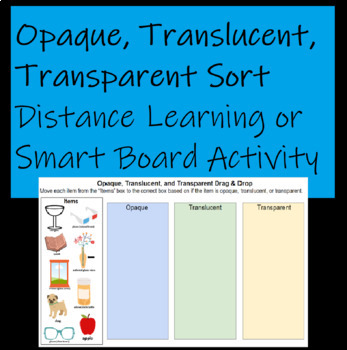Opaque, Translucent, Transparent Drag & Drop on GOOGLE SLIDES - Digital
- Google Slides™

What educators are saying
Description
This resource is a one-slide digital Google Slides activity in which students can drag and drop each item into the corresponding box (opaque, translucent, or transparent). DO NOT USE IN PRESENTATION MODE. Your students may open the document as if to edit to freely move the pictures around (don't worry, the directions and boxes will stay in the right place!). This activity is great for practice or a quick assessment . I used a similar activity on a smart board with my first graders, and they LOVED it! First grade standards covering light and shadows may include opaque, translucent, and transparent (check your state), but it is also covered in middle school science standards here in NY. This slide is an appropriate distance learning activity for any age given that the students know how to open the document and move the items around. For face-to-face classes, this is a fun group activity using your smart board!


